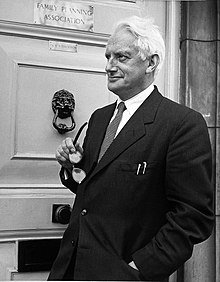| Sir Alan Sterling ParkesFRS CBE | |
|---|---|
 | |
| Born | 10 September 1900 |
| Died | 17 July 1990 (aged 89) |
| Alma mater | Christ's College, Cambridge University of Manchester |
| Awards | Cameron Prize for Therapeutics of the University of Edinburgh (1962) |
| Scientific career | |
| Fields | Reproductive biology |
Sir Alan Sterling Parkes, FRS, CBE (10 September 1900 – 17 July 1990) was an English reproductive biologist credited with Christopher Polge and Audrey Smith for the discovery that spermatozoa can be protected against induced damage induced by freezing and low-temperature storage using glycerol. This work enabled the development of the field of cryobiology.
Hall was educated at Willaston School.
He published on the reproductive effects of X-rays on mice, hormonal control of secondary sexual characteristics in birds, and aided Hilda Bruce in research that established the Bruce effect.
In 1962, Parkes was awarded the Cameron Prize for Therapeutics of the University of Edinburgh.
References
- Polge, C.; Smith, A. U.; Parkes, A. S. (1949). "Revival of Spermatozoa after Vitrification and Dehydration at Low Temperatures". Nature. 164 (4172): 666. doi:10.1038/164666a0. ISSN 1476-4687. PMID 18143360. S2CID 4072629.
- ^ Polge, Christopher (2006). "Sir Alan Sterling Parkes. 10 September 1900 — 17 July 1990: Elected FRS 1933". Biographical Memoirs of Fellows of the Royal Society. 52: 263–283. doi:10.1098/rsbm.2006.0019. ISSN 0080-4606. PMID 18543475.
- "Willaston School Nantwich - Willaston Web". www.willastonweb.co.uk. Willaston Web. Retrieved 21 May 2021.
- "Parkes, Sir Alan Sterling (1900–1990), reproductive biologist". Oxford Dictionary of National Biography (online ed.). Oxford University Press. 2004. doi:10.1093/ref:odnb/40018. ISBN 978-0-19-861412-8. Retrieved 2020-05-12. (Subscription or UK public library membership required.)
- Lamming, G.E., ed. (1994). Marshall's Physiology of Reproduction. Vol. 3 (4th ed.). Chapman & Hall. pp. xviii. doi:10.1007/978-94-011-1286-4. ISBN 978-94-010-4561-2. S2CID 36620187.
This article about a biologist is a stub. You can help Misplaced Pages by expanding it. |